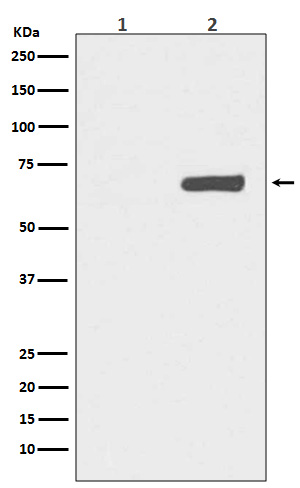Phospho-YAP1 (S127) Antibody
Rabbit mAb
- 产品详情
- 实验流程
Application
| WB, IHC |
|---|---|
| Primary Accession | P46937 |
| Reactivity | Rat, Human, Mouse |
| Clonality | Monoclonal |
| Other Names | 65 kDa Yes associated protein; YAP; YAp 1; YAP2; YAP 65;YKI; Yorkie homolog; |
| Isotype | Rabbit IgG |
| Host | Rabbit |
| Calculated MW | 54462 Da |
| Dilution | WB 1:5000~1:20000 IHC 1:50~1:200 |
|---|---|
| Purification | Affinity-chromatography |
| Immunogen | A synthesized peptide derived from human YAP1 |
| Description | YAP (Yes-associated protein, YAP65) was identified based on its ability to associate with the SH3 domain of Yes. Transcriptional regulator which can act both as a coactivator and a corepressor and is the critical downstream regulatory target in the Hippo signaling pathway that plays a pivotal role in organ size control and tumor suppression by restricting proliferation and promoting apoptosis. |
| Storage Condition and Buffer | Rabbit IgG in phosphate buffered saline , pH 7.4, 150mM NaCl, 0.02% sodium azide and 50% glycerol. Store at +4°C short term. Store at -20°C long term. Avoid freeze / thaw cycle. |
| Name | YAP1 (HGNC:16262) |
|---|---|
| Synonyms | YAP65 |
| Function | Transcriptional regulator with dual roles as a coactivator and corepressor. Critical downstream regulatory target in the Hippo signaling pathway, crucial for organ size control and tumor suppression by restricting proliferation and promoting apoptosis (PubMed:17974916, PubMed:18280240, PubMed:18579750, PubMed:21364637, PubMed:30447097). The Hippo signaling pathway core involves a kinase cascade featuring STK3/MST2 and STK4/MST1, along with its regulatory partner SAV1, which phosphorylates and activates LATS1/2 in complex with their regulatory protein, MOB1. This activation leads to the phosphorylation and inactivation of the YAP1 oncoprotein and WWTR1/TAZ (PubMed:18158288). Phosphorylation of YAP1 by LATS1/2 prevents its nuclear translocation, thereby regulating the expression of its target genes (PubMed:18158288, PubMed:26598551, PubMed:34404733). The transcriptional regulation of gene expression requires TEAD transcription factors and modulates cell growth, anchorage-independent growth, and induction of epithelial- mesenchymal transition (EMT) (PubMed:18579750). Plays a key role in tissue tension and 3D tissue shape by regulating the cortical actomyosin network, acting via ARHGAP18, a Rho GTPase activating protein that suppresses F-actin polymerization (PubMed:25778702). It also suppresses ciliogenesis by acting as a transcriptional corepressor of TEAD4 target genes AURKA and PLK1 (PubMed:25849865). In conjunction with WWTR1, regulates TGFB1-dependent SMAD2 and SMAD3 nuclear accumulation (By similarity). Synergizes with WBP2 to enhance PGR activity (PubMed:16772533). |
| Cellular Location | Cytoplasm. Nucleus. Cell junction, tight junction {ECO:0000250|UniProtKB:A0A8C0NGY6}. Cell membrane. Note=Both phosphorylation and cell density can regulate its subcellular localization (PubMed:18158288, PubMed:20048001). Phosphorylation sequesters it in the cytoplasm by inhibiting its translocation into the nucleus (PubMed:18158288, PubMed:20048001, PubMed:34404733). At low density, predominantly nuclear and is translocated to the cytoplasm at high density (PubMed:18158288, PubMed:20048001, PubMed:25849865). PTPN14 induces translocation from the nucleus to the cytoplasm (PubMed:22525271). In the nucleus, phosphorylation by PRP4K induces nuclear exclusion (PubMed:29695716). Localized mainly to the nucleus in the early stages of embryo development with expression becoming evident in the cytoplasm at the blastocyst and epiblast stages (By similarity) Localizes to the cytoplasm and tight junctions following interaction with AMOT isoform 1 (PubMed:21205866). Localizes to tight junctions following interaction with AMOTL2 (By similarity). Translocates to the nucleus in the presence of SNAIL1 (By similarity). Found at the cell membrane in keratinocytes in response to mechanical strain (PubMed:31835537). {ECO:0000250|UniProtKB:A0A8C0NGY6, ECO:0000250|UniProtKB:P46938, ECO:0000269|PubMed:18158288, ECO:0000269|PubMed:20048001, ECO:0000269|PubMed:21205866, ECO:0000269|PubMed:22525271, ECO:0000269|PubMed:25849865, ECO:0000269|PubMed:29695716, ECO:0000269|PubMed:31835537, ECO:0000269|PubMed:34404733} |
| Tissue Location | Increased expression seen in some liver and prostate cancers. Isoforms lacking the transactivation domain found in striatal neurons of patients with Huntington disease (at protein level). |
Research Areas
For Research Use Only. Not For Use In Diagnostic Procedures.
Application Protocols
Provided below are standard protocols that you may find useful for product applications.
终于等到您。ABCEPTA(百远生物)抗体产品。
点击下方“我要评价 ”按钮提交您的反馈信息,您的反馈和评价是我们最宝贵的财富之一,
我们将在1-3个工作日内处理您的反馈信息。
如有疑问,联系:0512-88856768 tech-china@abcepta.com.
¥ 1,500.00
Cat# AP90744























 癌症的基本特征包括细胞增殖、血管生成、迁移、凋亡逃避机制和细胞永生等。找到癌症发生过程中这些通路的关键标记物和对应的抗体用于检测至关重要。
癌症的基本特征包括细胞增殖、血管生成、迁移、凋亡逃避机制和细胞永生等。找到癌症发生过程中这些通路的关键标记物和对应的抗体用于检测至关重要。 为您推荐一个泛素化位点预测神器——泛素化分析工具,可以为您的蛋白的泛素化位点作出预测和评分。
为您推荐一个泛素化位点预测神器——泛素化分析工具,可以为您的蛋白的泛素化位点作出预测和评分。 细胞自噬受体图形绘图工具为你的蛋白的细胞受体结合位点作出预测和评分,识别结合到自噬通路中的蛋白是非常重要的,便于让我们理解自噬在正常生理、病理过程中的作用,如发育、细胞分化、神经退化性疾病、压力条件下、感染和癌症。
细胞自噬受体图形绘图工具为你的蛋白的细胞受体结合位点作出预测和评分,识别结合到自噬通路中的蛋白是非常重要的,便于让我们理解自噬在正常生理、病理过程中的作用,如发育、细胞分化、神经退化性疾病、压力条件下、感染和癌症。







